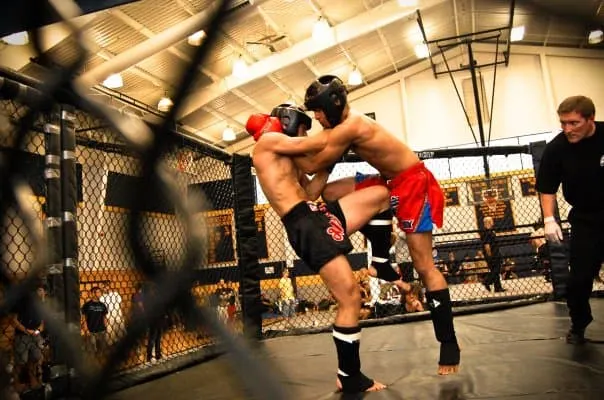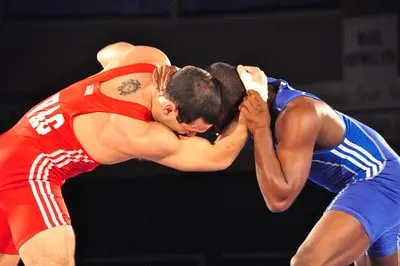
One of the core elements of MMA fighting is the clinch. It has been successfully used by MMA fighters and is used across a range of fighting styles.
A clinch is designed to put an opponent into a hold. This gives the fighter more control of their opponent’s movements. Once in the clinch, they might want to land punches and kicks. Alternatively, being in a clinch position will enable the fighter to throw their opponent to the mat much easier.
In this article, I will explain how the clinch is used in MMA as simply as possible if you are not familiar with this technique.
What is a Clinch in MMA?
Let’s start by looking at what a clinch is. Simply put, this is when one fighter puts another into a hold. Once they have them in a hold, they can drag the opponent to the ground. Sometimes, they will use it as an opportunity to punch or kick them. The most important element, though, is to remain in control of their movements.
This has become a prominent part of MMA because of the multiple fighting styles that use it. The most obvious example of this is wrestling, both Greco-Roman and freestyle. Wrestlers use the clinch to be able to hold and manipulate the opponent, often the aim will be to pin them to the mat.

Photo by MartialArtsNomad.com
However, other fighting styles use a clinch. Some of the most prominent examples are;
- Muay Thai
- Judo
- Brazilian Ju-Jitsu (BJJ)
- Boxing
These martial arts which use clinch have a stronger emphasis on offense. For example, Muay Thai emphasis throwing the opponent to the mat and trying to land punches on the way down.
Fighters who embrace these styles have shown how effective a good clinch can be. Because of this, it has been able to achieve more mainstream appeal. As an MMA fighter, knowing how to properly execute clinch or defend against clinch is one of the fundamental techniques that every fighter learns.
Why Do MMA Fighters Clinch?
To better understand why the clinch has become an essential technique of MMA, we need to look at some of the advantages and disadvantages of using it during a match.
Advantages
There are dozens of reasons to use a good clinch hold. These include;
- Controlling the opponent: When applied well a clinch hold will give a fighter more control over the movements of their opponent. This can put them into a position where they will be able to land good offensive maneuvers. Controlling their movements is also a good technique for scoring points with the judges.
- Tire an opponent: When in a clinch hold, the opponent will need to expend a lot of energy to break it. The more tired the opponent becomes, the more likely they are to make a mistake.
- Evens out the fight: It’s rare for a fight to be even. One person will usually have a height advantage. A clinch hold is a good way for fighters to neutralize this threat. Some clinch techniques have been designed for a smaller person to use against a larger opponent.
- Can be used for a takedown: In MMA, a clinch position is often used to set up for a takedown. Taking an opponent to the ground can significantly limit the opponent’s movements on their back. Once the opponent is on the ground, the fighter can deliver strikes, without the opponent able to hit back. Alternatively, this can be used as a set-up for a submission move.
Disadvantages
There are also some situations where fighters will avoid applying the clinch. These include:
- Requires close contact with the opponent: One of the biggest risks of this technique is getting close enough to the opponent to apply the clinch hold. When closing the distance to apply the clinch, there is a greater risk that they will get punched or kicked against a very good striker.
- Risk of a reversal: Another potential concern is that their opponent will be able to reverse the hold. A good grappler often prefers to be in the clinch position because it enables them to apply their submission moves more easily such as standing kimura.
Can You Punch in a Clinch?
In an MMA fight, fighters will be able to punch in a clinch. However, because this involves lifting a hand off their opponent, it’s most common for them to kick instead. These can be knees to the chest. These are designed to force the opponent to lean forwards. Once they do, they will be opening themselves to the potential of getting punched.
These rules are very different from the ones that apply in boxing, where boxers can’t apply a clinch for more than a few seconds before the referee breaks it. Punching an opponent while tangled up in a clinch position is sometimes referred to as dirty boxing. In MMA, as long as there is action occurring in the clinch, the hold can continue.
Alternatively, they might also try to kick the legs. When doing this, they will be able to knock their opponent off-balance, this can make a takedown a lot easier.
While the MMA rules have been designed to give fighters a lot of latitudes, there are a few things that will be banned during the clinch. First, they won’t be able to grab or hold the fence for the following reason:
“Fighters grab the cage when they’re attempting to jostle for position in the clinch, avoid a takedown or when they’re badly rocked and don’t know what’s going on. Grabbing the cage can result in a warning from the referee, point deductions and a reset in the center of the Octagon.”
Bleacherreport
How Do You Clinch in a Fight?
There are a few methods that you can use to apply the clinch against a striker. These are:
- The flying knee: The first step of this process is to block a punch with the palm of your hand. As you are doing this, grab their fist. Then, deliver a flying kick to their torso. This should force them to bow their head. Once they do, you can grab the back of their neck and begin the clinch.
- The steering wheel: In this case, you will need to grab control of their hands. Once you do, you can get hold of their biceps. This will allow you to stop them from throwing a punch.
- Ducking the head: If you have fast movement, you might want to duck your head under the punch. As you do, rush forward to get under the arm of the opponent. From there, you can go on the offense, landing strikes. Or you can use the position to clinch up.
Final Thoughts
The clinch is one of the most important elements of MMA. It has been used in various styles from wrestling to Muay Thai. Being able to get an opponent into a clinch will give the fighter an upper hand. They can control their movement, landing blows or bringing an opponent to the mat. Because of this, learning how to successfully apply and break a clinch could be the key to winning an MMA match.
